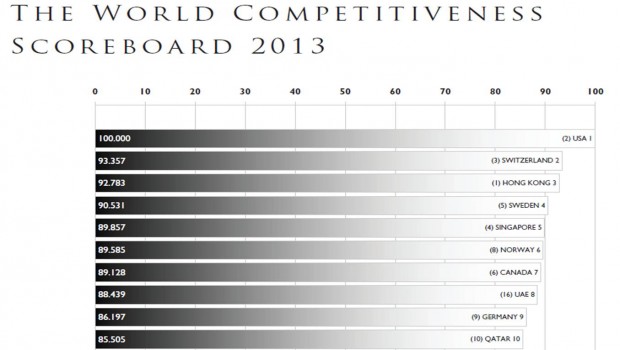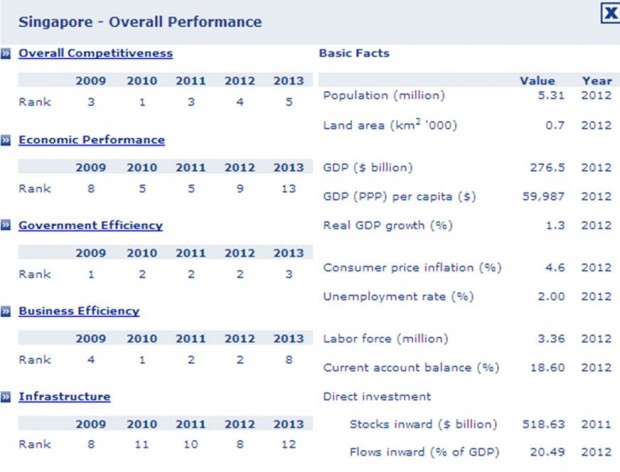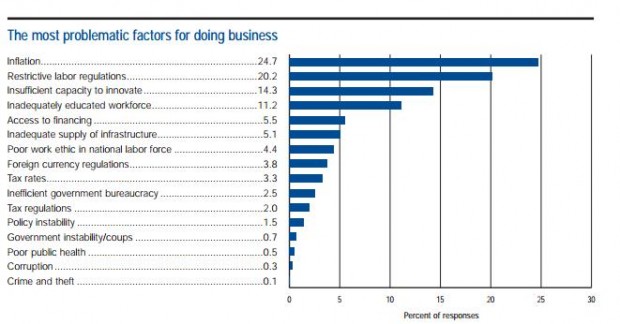The results from International Institute for Management Development (IMD) 25th Anniversary World Competitiveness Rankings should send a chill down every Singaporeans’ heart. With reference to The World Competitiveness Scoreboard 2013 which ranked economies from the most to the least competitive, Singapore has fallen from 4th to 5th position (2012 rankings are in brackets). We have long been proud of our Little Red Dot’s economical achievement in the global arena despite our physical limitations but are we still as competitive as we should be? Why did our competitiveness drop? Is this a temporary concern or a sign of long-term decline?
Before we get down to answer that question, let us first examine the reliability of this ranking system. IMD is internationally recognized as a top-ranked global business school that’s based in Switzerland. The IMD World Competitiveness Center (WCC) has been a pioneer in the field of competitiveness of nations and enterprises since 1989 and works closely with a network of 54 partner institutes worldwide to provide the government, business and academic community with the IMD World Competitiveness Yearbook – the holy grail of global competitiveness. Here’s a quick video to bring you up to speed on its 2013 rankings:
IMD World Competitiveness Yearbook 2013 Summary
In summary, the highlights of the 2013 ranking are as follows:
– The US has regained the No. 1 spot thanks to a rebounding financial sector, an abundance of technological innovation and successful companies.
– China (21) and Japan (24) are also increasing their competitiveness. In the case of Japan, Abenomics seems to be having an initial impact on the dynamism of the economy.
– In Europe, the most competitive nations include Switzerland (2), Sweden (4) and Germany (9), whose success relies upon export-oriented manufacturing, diversified economies, strong small and medium enterprises (SMEs) and fiscal discipline. Like last year, the rest of Europe is heavily constrained by austerity programs that are delaying recovery and calling into question the timeliness of the measures proposed.
– The BRICS economies have enjoyed mixed fortunes. China (21) and Russia (42) rose in the rankings, while India (40), Brazil (51) and South Africa (53) all fell. Emerging economies in general remain highly dependent on the global economic recovery, which seems to be delayed.
Learnings from the Winners
How did the first four countries beat Singapore in the rankings?
– Global Most Competitive Nation United States has higher economic performance, business efficiency and infrastructure.
– Sweden and Switzerland have developed higher business efficiency and infrastructure.
– Hong Kong has achieved higher economic performance and government efficiency.
What Does Our Drop in Competitiveness Tell Us?
Compared to countries that have experienced a drop in more than 5 positions, Singapore is not exactly a terrible loser this time round. But when kiasu Singaporean parents will tell you how serious it is for their kid to drop one position in class ranking, how can we not care about why our Little Red Dot drops one rank in global competitiveness?
A quick look at the performance breakdown revealed a significant drop in ranks from 2012 to 2013:
– Business Efficiency dropped from 2 to 8
– Economic Performance suffered from 9 to 13
– Infrastructure declined from 8 to 12
Let’s first take a look at Business Efficiency & Economic Performance. In my previous post on NTUC May Day Rally 2013, Mr Lim Swee Say explained how our economy is transitioning from a “3 + 1 = 4” to a “1 + 2 = 3” economy.
As we reduce reliance on foreign labour, workforce growth has fallen from 3% to 1%,
we were hoping to make it up with an increase in productivity growth from 1% to 2%,
hence enabling Singapore economy to reach a slightly compromised GDP growth from 4% to 3%.
Please see Mr Lim Swee Say’s explanation during NTUC May Day 2013 Rally here:
Unfortunately, we might have over-compromised hence resulting in a sharp fall in business efficiency due to rising business costs and drop in productivity.
Infrastructure is also a huge problematic area that Singapore faces. Good quality infrastructure is a key ingredient for sustainable development. We need efficient transport, sanitation, energy and communications systems to prosper and provide a decent standard of living for Singaporeans. Unfortunately, our population may be expanding way too fast for our infrastructure to catch up.
Another global competitiveness report by World Economic Forum also identified the most problematic factors for doing business in Singapore.
How Can Singapore Be More Competitive?
As much as Singaporeans would love to have a slower pace of life, economic growth remains very much a prerequisite for competitiveness. In relatively good times today, we may have gotten a little complacent and think that we can afford to rest on our laurels and take a short breather. We are after all still among the top 5 most competitive nations in the world right?
Taking reference from the popular Children Classics – The Tortoise And The Hare, Singapore may be referred to as the Hare at the moment. Do we want to make the mistake of relaxing for one year only to find out next year and beyond that we have been surpassed by more of our competitors? Furthermore, our competitors are not exactly the typical Tortoises either.
From its analysis of the 2013 result, WCC has highlighted the following factors as the main drivers behind a nation’s competitiveness: manufacture, diversify, export, invest in infrastructure, educate, support SMEs, enforce fiscal discipline, and above all maintain social cohesion. This means, to be in the lead, it takes all hands on deck i.e. government, companies, unions and the workers, to focus their energies towards the common cause of contributing to Singapore’s competitiveness.
Although the government is investing in infrastructure and consistently exploring new technologies, civil servants should strive to work more closely with the other 3 stakeholders (companies, unions and workers) to forecast skill sets and infrastructure needs that are likely to be required in both the short and long run.
When it comes to manufacturing, diversification and eventual export of its goods & services, companies must continuously innovate to create products the world wants (not create products to sell to the world), invest in systems and processes to serve customers cheaper, better and faster, and network aggressively to expand export markets.
All stakeholders (government, unions, companies, workers) should work towards making a mutually-beneficial employer-employee relationship a business norm, where companies are convinced that they stand to benefit from investing in productivity measures and valuing each worker to maximize (not exploit) the ability of a limited number of workers in this small country, and where workers are empowered to suggest and implement improvements and new ideas. With more productivity and higher profits, not only are wages are able to rise but so will Singapore’s competitiveness.
However, this social cohesion is currently social confusion. Social cohesion cannot be achieved by just one, two or three out of these four stakeholders. Everyone has to play their part of the equation. Even though our government needs to have their ears on the ground and set the appropriate policies that benefits Singaporeans first, companies should overcome their fears and inertia to pick up the baton and charge ahead, or risk being left behind.
Singaporeans must also be committed to work hard and enhance our nation’s competitiveness if the country takes the extra effort to look after our livelihood and effectively tighten the foreign labour market through a rigorous labour market testing process.
Companies should try their best to fill a position with suitably qualified Singaporeans first before opening up the position to foreigners. Detailed justifications should be in place to explain why the position could not be filled by a local Singaporean. An independent committee should be commissioned to audit these justification papers on an annual basis.
Having said that, foreigners with global exposure and knowledge should still be welcomed to advise companies as external consultants so as to allow our local management and staff to get up to speed with best market practices and stay competitive. In this way, Singaporeans need not worry about job security and companies can value every worker by developing their skill sets through interactions and engagement with these foreign consultants.
So employer and employee in Singapore, are we ready to step up and start running?









